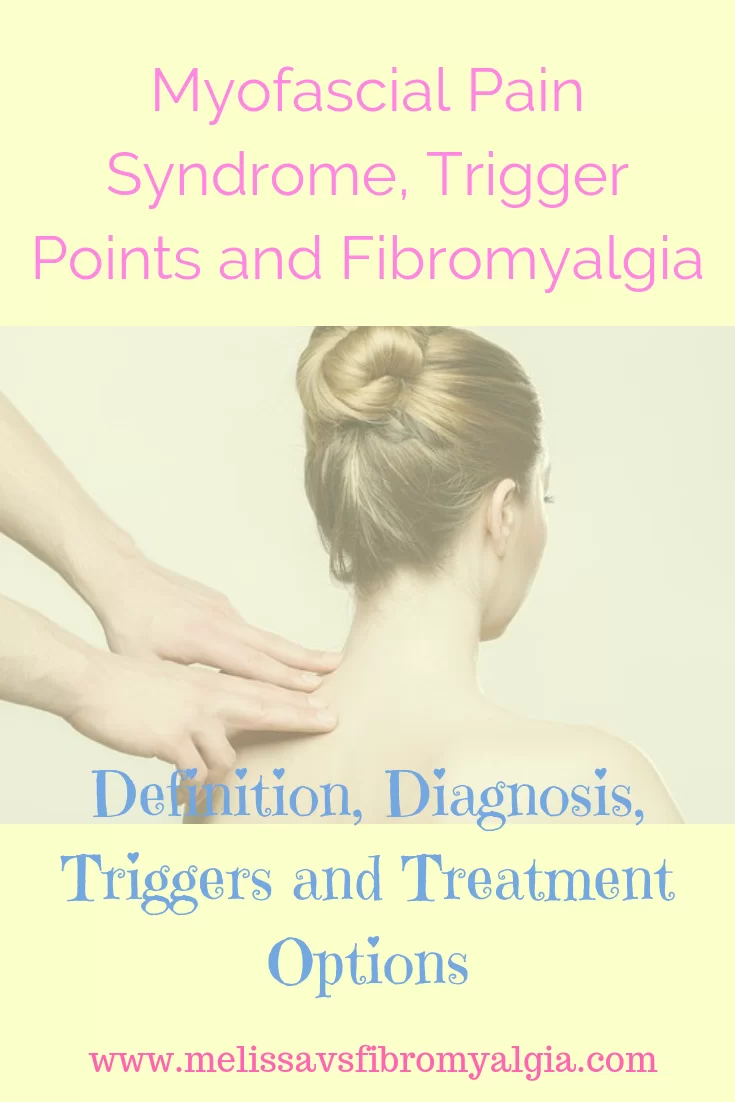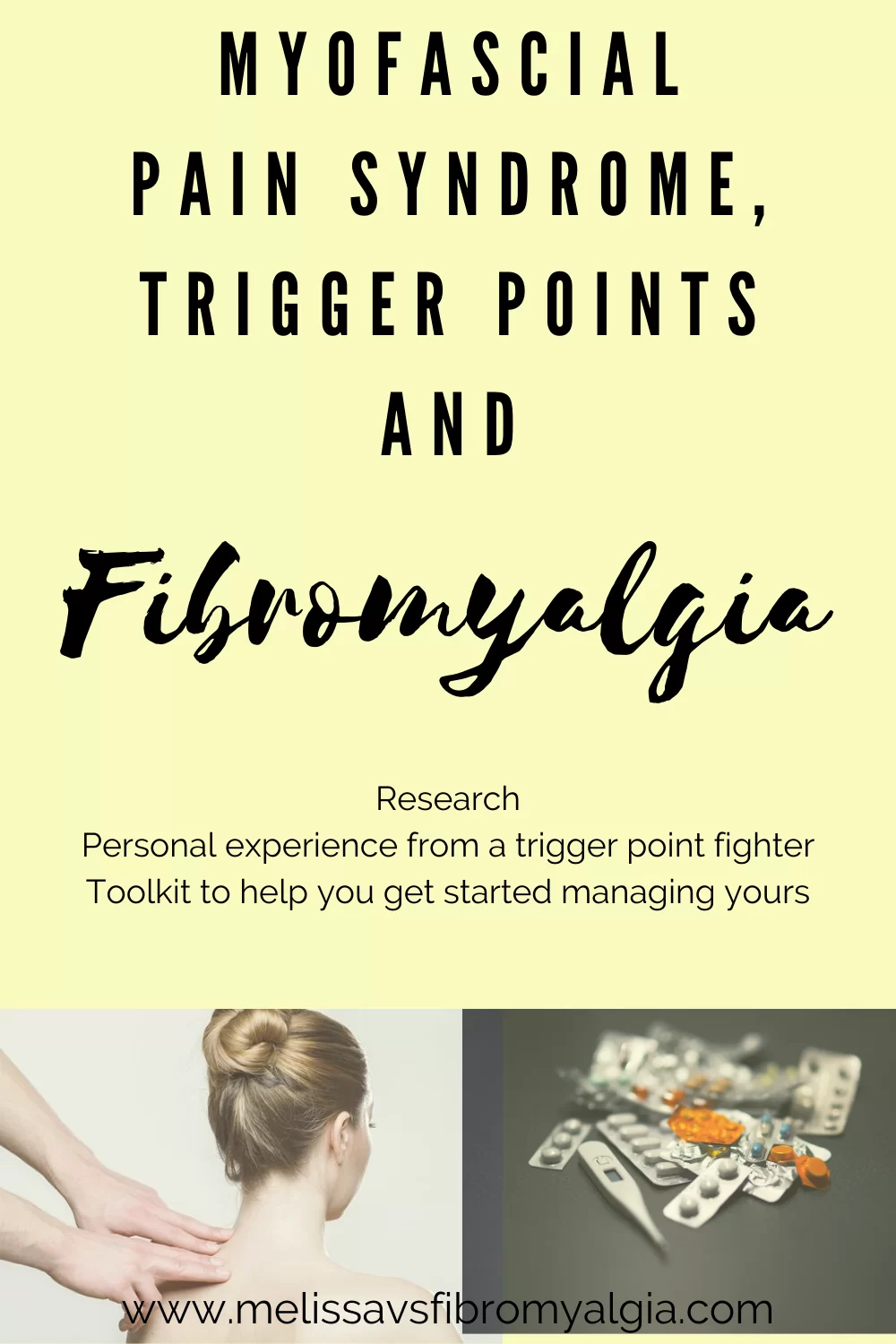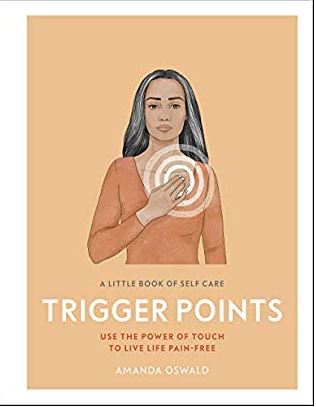Last Updated on December 18, 2020 by melissanreynolds
Myofascial Pain Syndrome (MPS) is a term I came across in 2017, when a physiotherapist finally explained that this is what was causing my severe neck issues. In this post we go through what it is, examine if it’s part of Fibromyalgia, and my at-home treatments.
Remember: I bring together research, resources and my personal experience as a STARTING point for your own consideration. Please always check in with your medical team. We are all so different in what works and doesn’t work that other people’s experiences are helpful but not going to be a template for you.
Also it is worth noting that a healthy person with trigger points is a much different proposition than someone with fibromyalgia. With the fibromyalgia we need to factor in the central sensitization and central nervous system overactivation. It’s complex!

Definition of Myofascial Pain Syndrome
A good definition of Myofascial Pain Syndrome that I have come across explains it as: “hyper irritable spots, usually within a taut band of skeletal muscle or in the muscle’s fascia that is painful on compression and can give rise to characteristic referred pain, tenderness, and autonomic phenomena” 1
Are Trigger Points Part of Fibromyalgia?
There is often confusion between the tender points characteristic of Fibromyalgia and trigger points. This article discusses the differences and similarities and provides a chart for distinguishing between the two.
The propensity for medical professionals to throw every symptom into the Fibromyalgia basket set me back for a decade. If they had realised prior to 2017 that my neck pain was really caused by trigger points, then we could have begun working on them sooner. These tiny hyper irritable spots have caused me over ten years of sleepless nights and 24/7 pain that nothing completely relieved.
Whether or not one wants to accept trigger points as part of Fibromyalgia or separate, research has noted that where trigger points are present in those with Fibromyalgia, the treatment of trigger points relieves the Fibromyalgia symptoms associated – such as pain in that area and fatigue.
Diagnostic Criteria and Prevalence for Myofascial Pain Syndrome
MPS does not have universally accepted diagnostic criteria, so it also does not have reliable statistics as to the prevalence. An estimate, using data around musculoskeletal pain in general puts estimates of myofascial pain as a patient’s primary complaint at 30%. 2
However the presence of a trigger point in the muscle that causes referred pain (and often secondary symptoms) is often enough for a physical therapist to treat these.
Other posts you may like:
Tools to Fight Fibromyalgia
My Top Three Treatments to Fight Fibromyalgia
9 Inexpensive Items I Use to Fight Fibromyalgia (including items I use to treat trigger points)
Causes or Contributing Factors for Trigger Points
- Fibromyalgia or other conditions, especially inflammatory ones
- Sleep deprivation
- Postural (including bad ergonomics at the computer)
- Trauma to the area
- Excessive or lack of exercise
- Emotional stress
- Fatigue
- Nutritional deficiencies
- Excess weight
Treatment for Trigger Points
The above quoted literature review (2) discusses general treatments for MPS: aside from eliminating as many aggravators of the condition as possible (like proper ergonomic posture at computers), treating any other present diseases, the treatment usually includes NSAIDS (usually stated as unhelpful for Fibromyalgia), heat pack, and acupuncture applied by a specific methodology.
In my case, I found that placing acupuncture needles into the trigger point (gently, without aiming for muscle reactions like in dry needling) and leaving them in for 10-15 minutes followed by neck mobilisations and tractions, provides the best relief I have found. By going to a physiotherapist to do this every three weeks, in addition to my home treatment plan, is the best way to treat the trigger points. But they always come back. We have made some progress over the past year, but they are always there and re-triggered rather easily.
Whatever may work for you, it is likely to be multi modal – involving a few treatment options, including pharmacologic and alternative approaches.
- Avoid perpetuating factors (this is huge)
- Hit the actual trigger points manually
- Dry needling
- Self-trigger point work
- Heat (to help the pain and muscle)
- Medicine (again for the pain and muscle)
- Stretching (I find dynamic stretching more valuable than static)
- Gentle exercise (to keep muscles healthy and moving)
- Isometric exercises
- Ultrasound
- Frequency-specific microcurrent therapy
My At-home Treatments for Trigger Points and Muscle Pain from Them:
- Heat: heat pack, hot bath or shower
- Topical creams: Essential oil blended pain cream, Deep Heat
- Trigger Point Massager cane for self-trigger point activation (you can use your fingers or thumbs but mine get too sore for the level of pressure needed)
- Rest/pacing
- Stretching/yoga
- Limiting computer time and using good ergonomic set up
- Medicines: Brufen, when they get to spasm level then a muscle relaxant
Yoga and Trigger Points
I find dynamic stretching the most useful for me. A lot of people love yoga and a lot of people say it doesn’t work at all for them. This is because what works for one doesn’t necessarily work for another. Also, one should delve into how you know if yoga helps. How have you tried it? Have you tried the different options on offer? If you have tried a class in a studio or a random YouTube class not designed for chronic pain then you likely haven’t tried the right yoga for you.
For chronic pain and fatigue we generally look at gentle, mindful movement with breath front and center. My trigger points seem to respond better to dynamic stretching, not long static holds with any weight bearing. So crow pose (a pose where you balance your body on your arms) really flares up my trigger points. But child’s pose (a supported, relaxing pose) makes me feel so much better.
Restorative yoga is a great, passive practice good for bringing the central nervous system down and helping the body to relax.
Slow flow yoga is a gentle practice where you mindfully move through a couple of poses. Like cat and cow pose together (I love this for my neck and back).
For us, a “class” can mean a two pose flow for a couple of minutes. Or a yoga nidra guided meditation for 30 minutes in the middle of the day. Or one 15 minute surrender into supported child’s pose.
Join us for the free five minutes a day for five days Yoga for Fibromyalgia challenge to see how it might feel for you.
But if yoga is not your cup of tea, check out the other ideas.
Your Trigger Point Toolkit
Affiliate notice: Some of my links are affiliate links. If you make a purchase using one of these links I may make a small commission at no extra cost to you.
The Little Book of Self Care Trigger Points: Use the Power of Touch to Live Life Pain-Free is the best book I’ve found explaining trigger points, what they do and how to treat them yourself. I highly recommend getting a copy of this book. There are clear pictures of what to do and how to do it.
The Trigger Point Therapy Workbook – this is a much more detailed (like a textbook) book about trigger points, perpetuating factors and how to treat. This is the gold standard of information, but it is trickier to understand. Highly worth getting into if you really want to tackle trigger points.
The Theracane Trigger Point Massager – this is my favourite tool for managing trigger points. My fingers get too sore to hold the pressure required to treat trigger points.
Foam roller – I have a small, firm foam roller which I like to use on the bigger muscles like glutes, legs and back.
Heat pack – this is one of the top five pain management mechanisms I use. I use my heat pack every single day. It is recommended to warm up the muscle you are treating before you try trigger point release. Afterward you can stretch and then reapply heat.
Deep heat cream – I use this on my neck, shoulders and back trigger points all the time. The heat infused cream combined with gentle massage is so good.
Yoga for Chronic Pain and Fatigue – here is my free five minutes a day for five days challenge for you to gently incorporate some yoga, stretching and breathing into your day. My focus is on dynamic stretching rather than long, static stretches but also in showing you how to find what feels best for you.
Your turn: Do you have trigger points too? How do you treat them?
- Travell, JG, Simons, DG. Myofascial Pain and Dysfunction. The Trigger Point Manual: Upper Half of Body, 2nd edition. Lippincott, Williams & Wilkins, Baltimore 1988.
- Overview of soft tissue rheumatic disorders Author:Irving Kushner, MDSection Editor:Zacharia Isaac, MDDeputy Editor:Monica Ramirez Curtis, MD, MPH Literature review current through: Mar 2018. | This topic last updated: May 12, 2017. on UptoDate.com



Thank you for the information, especially the link to the chart differentiating fibromyalgia and myofascial pain syndrome. I definitely get the “jump sign” during my medical examinations.
This is interesting because the description you listed here is exactly what I have. Never thought it might be a trigger point for some reason (I don’t have fibro). The ‘knot’ or trigger point tends to be in the same place, and I can feel it. Sometimes I need to press it for a while then it disappears as quickly as it came.